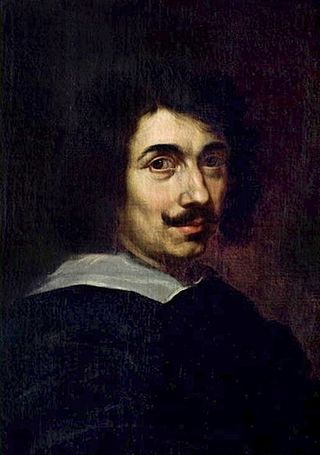
Claude Lorrain was a French painter, draughtsman and etcher of the Baroque era. He spent most of his life in Italy, and is one of the earliest significant artists, aside from his contemporaries in Dutch Golden Age painting, to concentrate on landscape painting. His landscapes often transitioned into the more prestigious genre of history paintings by addition of a few small figures, typically representing a scene from the Bible or classical mythology.

Antonio Allegri da Correggio, usually known as just Correggio was an Italian Renaissance painter who was the foremost painter of the Parma school of the High Renaissance, who was responsible for some of the most vigorous and sensuous works of the sixteenth century. In his use of dynamic composition, illusionistic perspective and dramatic foreshortening, Correggio prefigured the Baroque art of the seventeenth century and the Rococo art of the eighteenth century. He is considered a master of chiaroscuro.

Andrea Mantegna was an Italian Renaissance painter, a student of Roman archeology, and son-in-law of Jacopo Bellini.

Giacomo Balla was an Italian painter, art teacher and poet best known as a key proponent of Futurism. In his paintings, he depicted light, movement and speed. He was concerned with expressing movement in his works, but unlike other leading futurists he was not interested in machines or violence with his works tending towards the witty and whimsical.

Gino Severini was an Italian painter and a leading member of the Futurist movement. For much of his life he divided his time between Paris and Rome. He was associated with neo-classicism and the "return to order" in the decade after the First World War. During his career he worked in a variety of media, including mosaic and fresco. He showed his work at major exhibitions, including the Rome Quadrennial, and won art prizes from major institutions.

Carlo Carrà was an Italian painter and a leading figure of the Futurist movement that flourished in Italy during the beginning of the 20th century. In addition to his many paintings, he wrote a number of books concerning art. He taught for many years in the city of Milan.

Giovanni Battista Cima, also called Cima da Conegliano, was an Italian Renaissance painter, who mostly worked in Venice. He can be considered part of the Venetian school, though he was also influenced by Antonello da Messina, in the emphasis he gives to landscape backgrounds and the tranquil atmosphere of his works.

The Rose Period comprises the works produced by Spanish painter Pablo Picasso between 1904 and 1906. It began when Picasso settled in Montmartre at the Bateau-Lavoir among bohemian poets and writers. Following his Blue Period – which depicted themes of poverty, loneliness, and despair in somber, blue tones – Picasso's Rose Period represents more pleasant themes of clowns, harlequins and carnival performers, depicted in cheerful vivid hues of red, orange, pink and earth tones.

Arthur Bowen Davies was an avant-garde American artist and influential advocate of modern art in the United States c. 1910–1928.
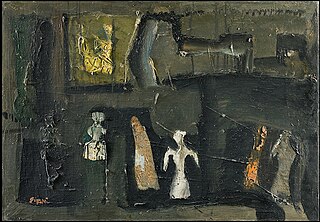
Mario Sironi was an Italian Modernist artist who was active as a painter, sculptor, illustrator, and designer. His typically somber paintings are characterized by massive, immobile forms.

Dante's Dream is a painting from 1871 by the English Pre-Raphaelite painter Dante Gabriel Rossetti. It hangs in the Walker Art Gallery, Liverpool.
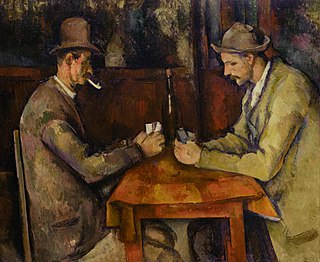
The Card Players is a series of oil paintings by the French Post-Impressionist artist Paul Cézanne. Painted during Cézanne's final period in the early 1890s, there are five paintings in the series. The versions vary in size, the number of players, and the setting in which the game takes place. Cézanne also completed numerous drawings and studies in preparation for The Card Players series.

Kazimierz Sichulski was a Polish painter, lithographer and caricaturist; associated with the Young Poland movement. His work was part of the painting event in the art competition at the 1928 Summer Olympics.

En premiär is an artwork by Swedish artist Anders Zorn, with several versions created from 1888 to 1895. The work was one of several works in which Zorn depicted woman bathing outdoors, a genre he described as "naked studies in the open". In this composition, a nude woman holding a small child at the edge of the water beside a beach. Different versions are held by the Nationalmuseum in Stockholm, the Ateneum in Helsinki, and the Museum of Fine Arts in Ghent.
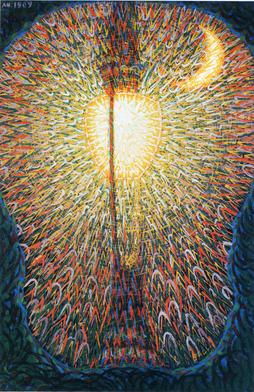
Street Light (also known as The Street Light: Study of Light and Street Lamp (Suffering of a Street Lamp)) (Italian: Lampada ad arco) is a painting by Italian Futurist painter Giacomo Balla, dated 1909, depicting an electric street lamp casting a glow that outshines the crescent moon. The painting was inspired by streetlights at the Piazza Termini in Rome.

Dynamism of a Dog on a Leash, sometimes called Dog on a Leash or Leash in Motion, is a 1912 oil painting by Italian Futurist painter Giacomo Balla. It was influenced by the artist's fascination with chronophotographic studies of animals in motion. It is considered one of his best-known works, and one of the most important works in Futurism, though it received mixed critical reviews. The painting has been in the collection of the Buffalo AKG Art Museum since 1984.
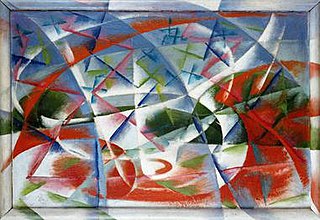
Abstract Speed + Sound is a painting by Italian Futurist painter Giacomo Balla, one of several studies of motion created by the artist in 1913–14.

















